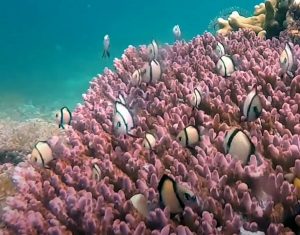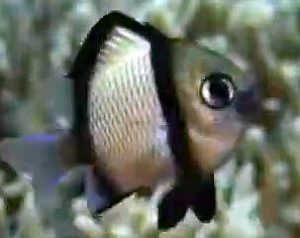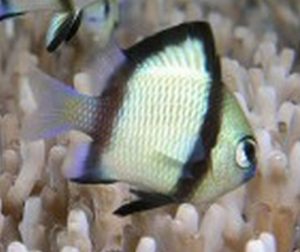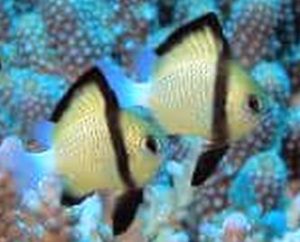Two Stripe Damselfish (Dascyllus reticulatus) known to tropical fish keeping enthusiasts as 2-Stripe Damsel, Reticulated Dascyllus, Headband humbug, Marginate damselfish, Reticulated puller, and Reticulated Damselfish, is found throughout Indo Pacific waters; from the Cocos Keeling Islands in the eastern Indian Ocean to Samoa and the Line Islands, north to Southern Japan, south to Rowley Shoals in the Eastern Indian Ocean and Lord Howe Island, Indonesia, Tonga, and Australia. This species is not found in the Hawaiian or Society Islands.
Two Stripe Damselfish have a silver gray to bluish green body color with two dark vertical bands and a blue green caudal fin. One band starts behind the gill plate and runs from the dorsal to the pectoral fins. The second starts at the rear of the dorsal fin just before the caudle peduncle and runs through the ventral fin.
Two Stripe Damselfish are similar in size, temperament, and behavior to Cloudy Damselfish (Dascyllus carneus)
Like Four Striped Damselfish, Two Stripe Damselfish are a social species usually found in shoals of 25 or
more individuals around staghorn Acropora and other isolated coral heads in the shallow lagoons and subtidal reefs of their range in depths from 3 to over 100 feet. Although usually encountered in schools or small harems, both juveniles and adults are often found alone in these same locales.
Dascyllus reticulatus is an active species that feed on microalgae, small crustaceans, and zooplankton during daylight hours and shelters among the coral heads during the night.
In an aquarium environment, juvenile Two Stripe Damselfish do well in pairs or a harem of five females and one male, but caution is needed when housing them with damsels of the same or other species. They are hermaphroditic and can change gender from female to male when a male is needed in a harem.
Two Stripe Damselfish are completely reef safe and can be housed in either a reef tank or FOLR aquarium of at least 55 gallon capacity with a sand or finely crushed coral substrate, plenty of mature live rock arranged into territories with crevices, caves, and overhangs for them to hide among, and a lot of swimming space. Ideally, each Striped Damsel should be provided a territory with its own rock cave or coral head.
Due the aggressive behavior of adults, juvenile Two Stripe Damsels can be raised in a FOLR community tank with other moderately aggressive species such as basslets, angels, and most clownfish. Mixing damsels with timid species such as cardinalfish, Chromis, or batfish should be avoided. Also, avoid housing them with Lionfish, Snappers, Groupers, Triggers, Eels, or any other predatory fish that can grow large enough to swallow them.
In a reef aquarium with corals and anemones, Two Stripe Damselfish will sometimes bond with an anemone in a symbiotic relationship. They will generally not harm invertebrates, corals, or disrupt the decoration in reef tanks.
Although Two Stripe Damselfish have been bred in an aquarium environment, the fry are difficult to raise and the acquisition price of this species does not justify breeding.
Two Stripe Damsels reproduce similar to other damsels in their genus. The males perform a mating “dance” to entice a female to lay her adhesive eggs in a prepared nest; typically a shell or smooth rock in the substrate near some type of cover. If the female is receptive, she will follow him to the nesting site, and deposit her eggs. The quantity of eggs varies from female to female can be well over 1,000 per mating. After the male fertilizes the eggs, he will guard and aerate them until they hatch out, usually in about three to four days. During this period, the male becomes extremely aggressive and allows no one near the nest.
In their natural habitat, the tiny fry in their larval stage drift with the current as plankton for about three weeks, feeding on zooplankton and phytoplankton before settling to the bottom as a partially developed damsel. A single male will often mate with several females in the harem during the breeding season.
In the wild, Two Stripe Damselfish feed on algae, fish eggs, small crustaceans, ostracods, amphipods, copepods, tunicates, benthic invertebrates, and other zooplankton.
In an aquarium environment with plenty of mature live rock, they will eagerly accept a wide range of live, frozen, and freeze dried foods including omnivore flakes, pellets, Spiurlina, brine shrimp, Mysis shrimp
, finely chopped fish fillets or shrimp, etc.
Small portions fed several times throughout the day are recommended over feeding one or two large portions.
Two Stripe Damselfish (Dascyllus reticulatus) are commonly available to tropical fish keeping enthusiasts in local fish stores and from online wholesalers, trans shippers, and retailers at prices varying from $3.99 to $5.50 at a purchase size of 3/4″ to 1-1/2 for small; and 1-1/4″ – 2″ for medium.
Minimum Tank Size: 55 gallons
Aquarium Type: Reef or FOLR
Care Level: Easy
Temperament: Aggressive
Aquarium Hardiness: Very Hardy
Water Conditions: 72-78°F, dKH 8 to 12 , pH 8.1 – 8.4, sg 1.020-1.025
Max. Size: 3.5″
Color Form: Black, Green, White
Diet: Omnivore
Compatibility: Reef
Origin: West Pacific
Family: Pomacanthidae
Lifespan: 5 years
Aquarist Experience Level: Beginner






